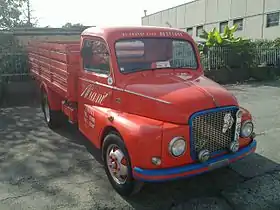Fiat 615
Fiat 615 was a model of Fiat light truck manufactured from 1951 to 1953 as a successor to the Fiat 1100ELR, with which it was still built in parallel. It had a total weight of 3,100 kg (6,834 lb), and was available in versions stake or van bodywork, chassis and carrozable for transportation and as a tractocamioón. Its cabin was the most Graned made by Fiat, and was inspired by the Model 640.
| Fiat 615 | |
|---|---|
 | |
| Overview | |
| Manufacturer | Fiat |
| Production | 1951–1965 |
| Body and chassis | |
| Class | Light utility truck |
| Powertrain | |
| Engine | Diesel Fiat 305 - 1.901 cm3 |
| Transmission | 4x2 |
| Dimensions | |
| Length | 4,995 mm (196.7 in) |
| Width | 1,924 mm (75.7 in) |
| Height | 1,920 mm (75.6 in) |
| Curb weight | 3,500 kg (7,716 lb) (with payload) |
| Chronology | |
| Predecessor | Fiat 1100ELR |
| Successor | Fiat 616 |
At first the model had a new petrol engine with 1395 cc and 29 kW (39 hp) at 3800 rpm to 1400 Fiat, and had a manual 4-speed transmission. A 1.5 ton truck was newly developed, which was offered from 1951 in a flatbed and chassis for special bodies. It was powered by the engine of the prior year, featured Fiat 1400s. The engine was already in the car Fiat 1400 was just sufficient, and with the 3.1 tons it had real trouble. Once in motion, the Fiat 615 was indeed 80 km/h (50 mph) fast, but with forced driving it had poor fuel efficiency. There was a reason that the 1100 Fiat ELR far built until 1954. The somewhat weaker beast of burden was, with its 1.1 liter and 28/30 PS (at 4400 rpm) a little lame, but it had fully loaded a ton to move less weight, so was more economical. It therefore retained its loyal following who forgave its manageable liveliness out of habit, especially as it came with start-up to a peak of over 90 km/h (56 mph) and thus was significantly faster than the Fiat 615 with its maximum of 78 km/h (48 mph).[1] With high pressure, therefore a suitable diesel engine was developed by Fiat: a swirl chamber engine (Ricardo System) based on the 1.9 liter engine for the "big" Fiat in 1900 and the new SUV Fiat Campagnola. (This engine was a hubvergrößerte variant of the 1400 engine.) The new diesel engine (type 305) was later also available in either sedan 1400 from 1952 in addition to the Fiat 615 N (N = Nafta = Diesel) and one year in Fiat Campagnola and Fiat. Although the experiment of the Fiat 615 built 1.9 L gasoline engine proved to be stronger and with faster drive spurt, confined themselves to the diesel, the Type 615 N. Only Steyr in Austria until 1958 offered the Fiat 615 as gasoline, as Steyr 260 with its own 50 hp 2 L gasoline engine from the car Steyr 2000. The Fiat 615 N was a very modern vehicle that, in Italy, initially had no competition. The export ran well at the beginning, missing, or half-hearted development left the Fiat 615 N (and especially its successor) over the years to become increasingly rare even in Italy. In Zastava in Yugoslavia, the Fiat 615 was built with a petrol engine under license. However, not as the beginning of the Fiat, with the 1.4 L 4-cylinder engine, but with the much stronger torque 1.9 liter engine (type 105) with 47 hp (35 kW) at 3500 rpm, as well as in the also at Zastava built under license, Campagnola was used. It is unclear whether the successor (from about 1963, as Fiat 615 N1) only with the 1.9 liter petrol engine (such as 615 B) was built, with a diesel engine.
Other variants
In addition to the flatbed, other variants with special bodies were made at Zastava, i.e. Zastava 620B crew cab, as was common in other Eastern European car factories (IFA, Csepel, Star, etc.).[2]
References
- Vittorio da Firenze. Benezit Dictionary of Artists. Oxford University Press. 2011-10-31.
- "FIAT 615". Retrieved 14 December 2013.